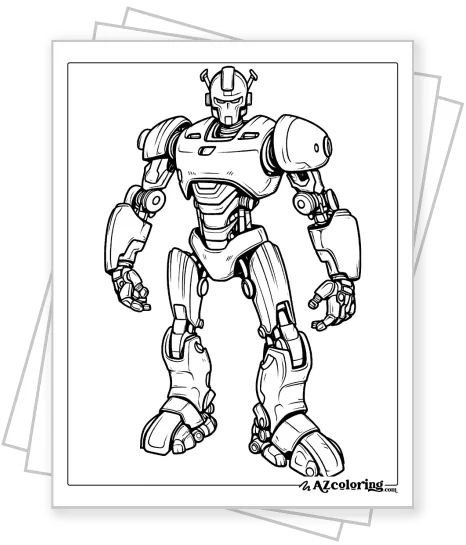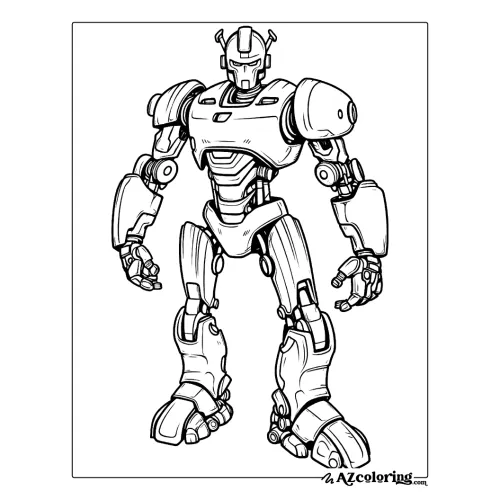Mechanical Robots Coloring Pages
(Free PDF Printables)
Download a free coloring page each day or go Plus+ to unlock them all.

Explore all Mechanical Robots Coloring Pages
Check our Mechanical Robots Coloring Pages and have fun. All pages are available in US Letter and A4 sizes.
What is in this Guide?
Explore Mechanical Robots Coloring Pages
Looking for an engaging way to delve into the world of mechanical robots? Our collection of free coloring pages blends technology with creativity. From intricate machinery details to futuristic robot designs, there’s something for everyone. Enjoy a diverse range of themes suitable for different ages and skill levels.
With multiple pages to choose from, you can explore various mechanical concepts in coloring form. Whether you’re a coloring enthusiast or just looking for a fun pastime, these pages offer hours of creativity. Download and enjoy as you bring these robots to life!

Explore our mechanical robots coloring pages today!
With over 2 captivating designs, there’s something for everyone to enjoy. Don’t wait—start your coloring adventure now!
Tips for Coloring Mechanical Robots Coloring Pages
Coloring mechanical robots isn’t just about filling spaces but exploring creativity. Below are some practical tips to enhance your coloring experience:
Focus on Shading.
Utilize shading techniques to create depth and dimension. Explore blending colors with pencils or markers to depict metallic robot surfaces realistically. This approach adds a three-dimensional feel.
Experiment with Metallic Colors.
Enhance the mechanical theme by incorporating metallic shades like silver, gold, or bronze. These colors emulate machinery parts and enhance the overall robot aesthetics.
Highlight with White.
Use a white pencil or gel pen for highlights on edges or joints to simulate light reflections. This simple trick adds realism and makes your robot designs pop off the page.
Craft Ideas To Do With Mechanical Robots Coloring Pages
Who says coloring stops at paper? Transform your mechanical robot coloring pages into exciting craft activities! Here’s how to take your creativity to the next level:
1. Robot Puppet.
Transform your favorite coloring page into a dynamic robot puppet. Start by coloring the page, focusing on vibrant hues for an engaging appearance. Carefully cut out the robot along the outline. Next, assemble the puppet with brass fasteners at the joints to allow movement.
For added stability, attach the robot to a popsicle stick using glue or tape. To create an interactive show, consider crafting multiple robots and using them for storytelling sessions. This activity is perfect for enhancing motor skills and fostering imaginative play.
2. 3D Robot Sculpture.
Bring your robot design to life by creating a 3D sculpture. After coloring your page, cut out individual robot parts. Use cardboard to trace and cut out the same shapes for a sturdy foundation. Glue the coloring paper onto the cardboard and assemble the pieces into a standing robot figure.
Invite kids to personalize their robots further by adding materials like pipe cleaners, googly eyes, or small accessories. This craft not only boosts artistic skills but also introduces three-dimensional thinking.
3. Robot-Themed Bookmark.
Turn your robot coloring page into a unique bookmark. After coloring, cut out a strip from the design, keeping interesting robot elements visible. Focus on using bold colors and keeping the edges neat.
Laminate the strip or cover it with clear tape to enhance durability, ensuring a stylish accessory for any book lover. This activity encourages reading while showcasing personalized creativity.
4. Robot Pin Badge.
Create wearable art by making a robot pin badge. Pick a small robot from your coloring page and color it vibrantly. Cut it out and laminate or coat it with a layer of clear nail polish for sturdiness.
Attach a pin backing available at craft stores to the back using strong adhesive. Wear your badge proudly or give it as a personalized gift to friends or family. This craft is excellent for showcasing personal style and creative expression.
5. Robot-Themed Greeting Card.
Use your colored pages to design personalized greeting cards. Cut out your robot design and glue it onto the front of a blank card. Add messages inside to celebrate occasions or share robot-themed jokes.
Encourage kids to write their messages with colorful pens or add stickers for an extra touch. Creating customized cards fosters communication skills and emphasizes the joy of giving handmade gifts.
FAQs about Mechanical Robots Coloring Pages
What are the benefits of coloring Mechanical Robots pages?
Coloring mechanical robots pages comes with numerous benefits. It enhances creativity by allowing individuals to experiment with colors and techniques. The detailed robot designs encourage focus and concentration, making it a relaxing activity suitable for stress relief.
Additionally, it helps in developing fine motor skills, especially in children, as they navigate between lines and intricate patterns. It can also serve as an introductory tool into robotics, sparking an interest in technology while providing an enjoyable artistic outlet.
What supplies do I need for coloring?
Coloring mechanical robots is simple and requires basic supplies. Start with coloring materials such as colored pencils, markers, or crayons based on your preference. They come in a variety of hues, allowing you to create vibrant or subtle artwork.
You might also consider metallic colors to enhance the mechanical effect. Having a set of basic drawing tools like erasers or sharpeners ensures precision. For younger artists, non-toxic, washable supplies are recommended to keep the activity safe and mess-free.
Can coloring help in learning about robots?
Yes, coloring robot pages can be an educational experience. It introduces basic concepts of robotic design and engineering in a fun, approachable manner. By engaging with these pages, children can gain insights into form and function.
Parents and educators can use coloring pages as a platform to discuss the principles of robotics, such as movement, structure, and purpose. This hands-on learning method blends art with technology, making complex concepts easier to understand while fostering imaginative play.

